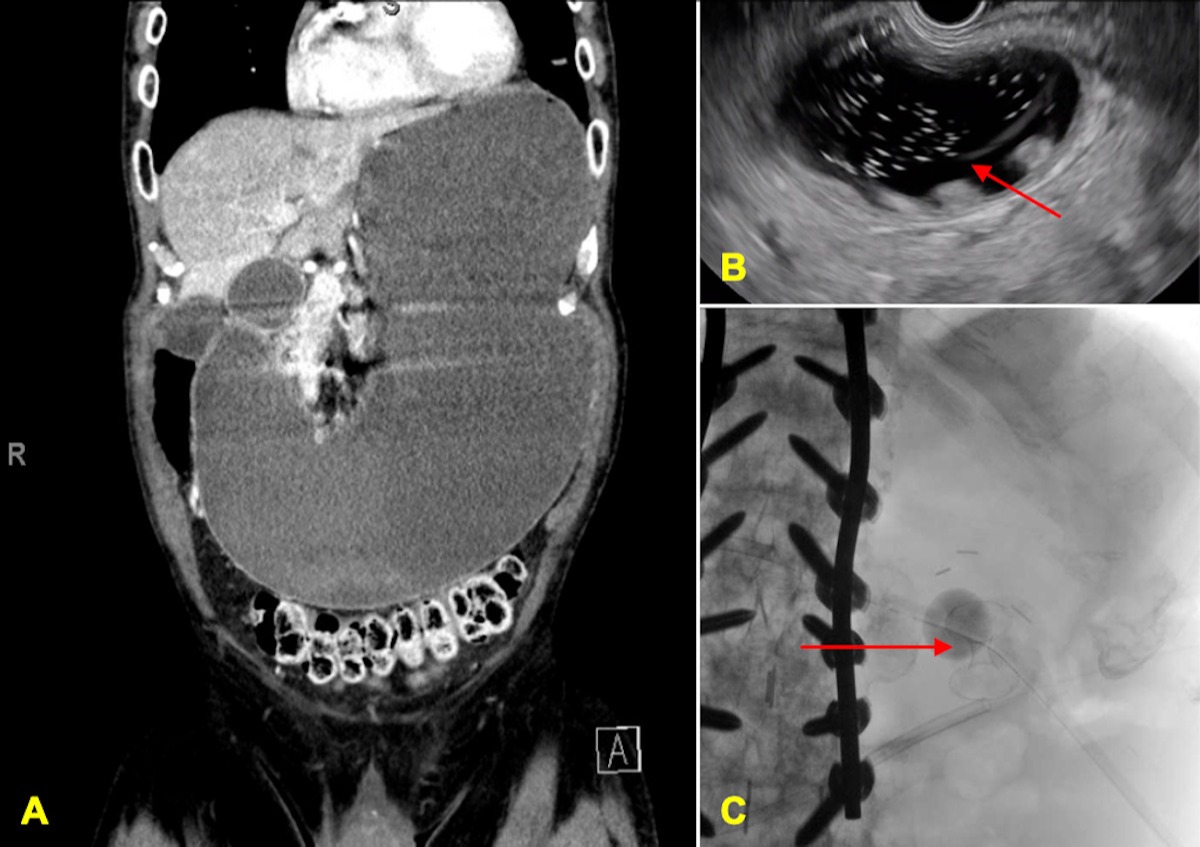Monday Poster Session
Category: Endoscopy Video Forum
P1793 - Endoscopic Ultrasound-Guided Gastrojejunostomy to Treat Gastric Outlet Obstruction From Superior Mesenteric Artery Syndrome

David E. Jonason, MD (he/him/his)
University of Minnesota
Salt Lake City, UT
Presenting Author(s)
1University of Minnesota, Minneapolis, MN; 2University of Minnesota Medical Center, Minneapolis, MN
Introduction:
Endoscopic ultrasound guided gastrojejunostomy (EUS-GJ) has emerged as a safe alternative to invasive surgery for therapeutic management of malignant gastric outlet obstruction (GOO). Its treatment role in benign GOO is less defined. We present a case of GOO from superior mesenteric artery syndrome (SMAS) treated by EUS-GJ.
Case Description/Methods:
A 77 year old male with history of dementia, coronary artery disease, type II diabetes, diverticulitis with prior colectomy, idiopathic pancreatitis and kyphosis developed new abdominal pain, distention and nausea one day following surgical revision of a C8-T2 cervical spine fusion. Computerized tomography (CT) revealed GOO with duodenal dilation proximal to where the third portion passes posterior to the superior mesenteric artery concerning for SMAS (Fig.1a). A percutaneous endoscopic gastrojejunostomy (PEG-J) tube was placed for decompression and enteric feeding with initial symptomatic improvement. He then returned ten days later with falls, acute kidney injury, hypokalemia and metabolic alkalosis with poor oral intake and increased PEG outputs, ~2 liters/day. Repeat CT scan was negative for ongoing obstruction. After multidisciplinary team discussion, endoscopic evaluation and treatment was pursued. Esophagogastroduodenoscopy (EGD) confirmed the J-tube appropriately in the jejunum with a benign-appearing stricture proximally in the duodenum. The decision was made to proceed with EUS-GJ. A dilated loop of proximal jejunum with the J-tube in place was endosonographically visualized adjacent to the gastric body,1000ml of saline was injected through the J-tube to approximate the lumens, and the common wall was interrogated with color Doppler for interposed vessels (Fig.1b). A cautery enhanced lumen-apposing metal stent (LAMS) delivery system was used to create a gastrojejunostomy followed by deployment of a 15 x 10-mm Axios stent (Boston Scientific, Natick, Massachusetts, USA) (Fig. 1c). Methylene blue injected through the J-tube emanated from the stent confirming its position. The procedure went without complications. He subsequently tolerated gradual diet advancement and is now gaining weight with plans for PEG-J removal and upsizing of the LAMS.
Discussion:
This case demonstrates the successful use of EUS-GJ to treat benign GOO from SMAS. This is a safe and effective alternative to endoscopic balloon dilation, enteric stenting or invasive surgery and should be considered in patients with benign GOO with high procedural risk.

Disclosures:
David Jonason, MD1, Guru Trikudanathan, MD2. P1793 - Endoscopic Ultrasound-Guided Gastrojejunostomy to Treat Gastric Outlet Obstruction From Superior Mesenteric Artery Syndrome, ACG 2023 Annual Scientific Meeting Abstracts. Vancouver, BC, Canada: American College of Gastroenterology.
